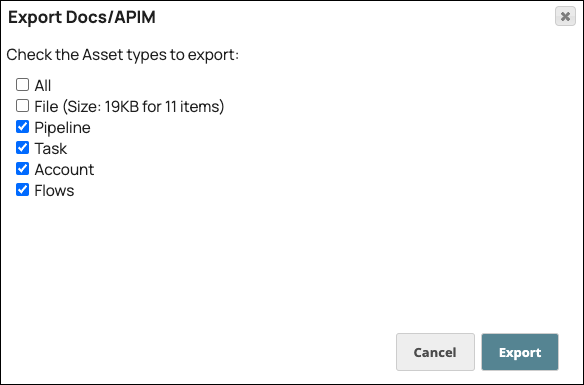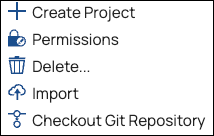In this article
| Table of Contents | ||||
|---|---|---|---|---|
|
Overview
SnapLogic Manager supports Project Import and Export operations. This enables you to copy SnapLogic Assets across Orgs. You can export a Project in the form of a Zip file containing all of the Pipelines, files, Flows, Accounts, and Tasks associated with the Project. Pipeline dependencies, such as child Pipelines and related accounts, are maintained during export. If you use different Orgs for development, testing, and production, you can then import the Project into the target Org. An accounts_template.json file is included in the exported JSON file. The Project Import wizard supports uploading the accounts template and a global expression file that defines variables for Account access. This enables you, as an Org admin, to maintain a master file for your account information and then change the variables across Orgs without changing the master file, supporting Continuous Integration and Continuous Development (CI/CD).
| Info |
|---|
SnapLogic Accounts Accounts are exported only when the Org supports encryption. SnapLogic, by default, has Standard Account Encryption (SAE) across all Orgs, unless an Org has opted for Enhanced Account Encryption. In SAE, accounts are encrypted with keys managed in the cloud. |
Export Projects
| Note |
|---|
|
To export a Project:
In SnapLogic Manager, hover your cursor over the Project to export, and click the arrow. The Project menu opens:
Select Export. The Export <Project Space>/<Project Name> dialog opens:
Select the Asset types that you want to export. Pipeline, Task, Account, and Flows options are selected by default. You can select All to export all assets or deselect any asset types from the project export.
Click Export to download the Project as a Zip file.
Import Projects
Known Issue
While importing a project with same name as an existing project and with the same assets tracked in Azure, the status for the updated assets is changed to Untracked.
To import a Project:
In SnapLogic Manager, hover your cursor over the Project Space to open the menu:
Select Import to open the Import Project dialog:
Click Choose File to upload the Project files:
Import Project Zip File*
Import Account JSON File (optional)
Import Expression Library Zip File (optional)
Select one of the following methods for handling duplicate assets within the project space or global
sharedfolder:Keep existing assets: Creates a new project and marks the duplicate imported assets with a number 1 at the end of the asset name.
Create a new project: Creates a new project with a number 1 at the end of the name and all assets from the import with their names intact. The Activity Log records the new project and/or pipeline and indicates that they are created by the import operation.
Overwrite existing assets: Allows you to select which assets (files, pipelines, tasks, accounts, and flows if applicable) to import and replaces any duplicate existing assets with the imported ones. The Activity Log records the new project and/or pipeline and indicates that they are created by the import operation.
When the file upload is complete, click Import. A confirmation message appears on the page, and the new project appears in the list of projects on the left.
You might need to do the following:Add files that are referenced if they were not a part of the project's export.
Edit the Tasks to select the Snaplex on which they must run.
| Note |
|---|
Important
|
Export Selected Assets
To export selected assets in Manager:
In SnapLogic Manager, hover your cursor over the project to export and click the arrow to open the menu. From the toolbar, click the Export icon.
Select Export. The Export <Project Space>/<Project Name> dialog opens:
Select the Asset types that you want to export. Pipeline, Task, and Account are selected by default. Select All to export all assets or deselect any asset types from the project export.
Click Export to download the Project as a Zip file.
Using the export icon on the project panel, the user can export selected assets.
Import Selected Assets
To import selected assets in Manager:
In SnapLogic Manager, hover your cursor over the project space to open the menu. Alternatively, you can use the import icon from the toolbar.
Select Import to open the Import project dialog.
Under the project space dropdown, the import user can import a project and under the project dropdown import, the user can import individual assets.
Click Choose file to upload the project files:
Import project ZIP file*
Import account JSON file (optional)
Import expression library ZIP file (optional)
Select one of the following methods for handling duplicate assets within the project space or global
sharedfolder:Keep existing assets: Creates a new project and marks the duplicate imported assets with a number 1 at the end of the asset name.
Overwrite existing assets: This allows you to select which assets (files, pipelines, tasks, accounts, and flows, if applicable) to import and replace any duplicate existing assets with the imported ones. The Activity Log records the new project and/or pipeline and indicates that the import operation creates them. When the file upload is complete, click Import. A confirmation message appears on the page, and the new assets appear in the list of projects on the left.










